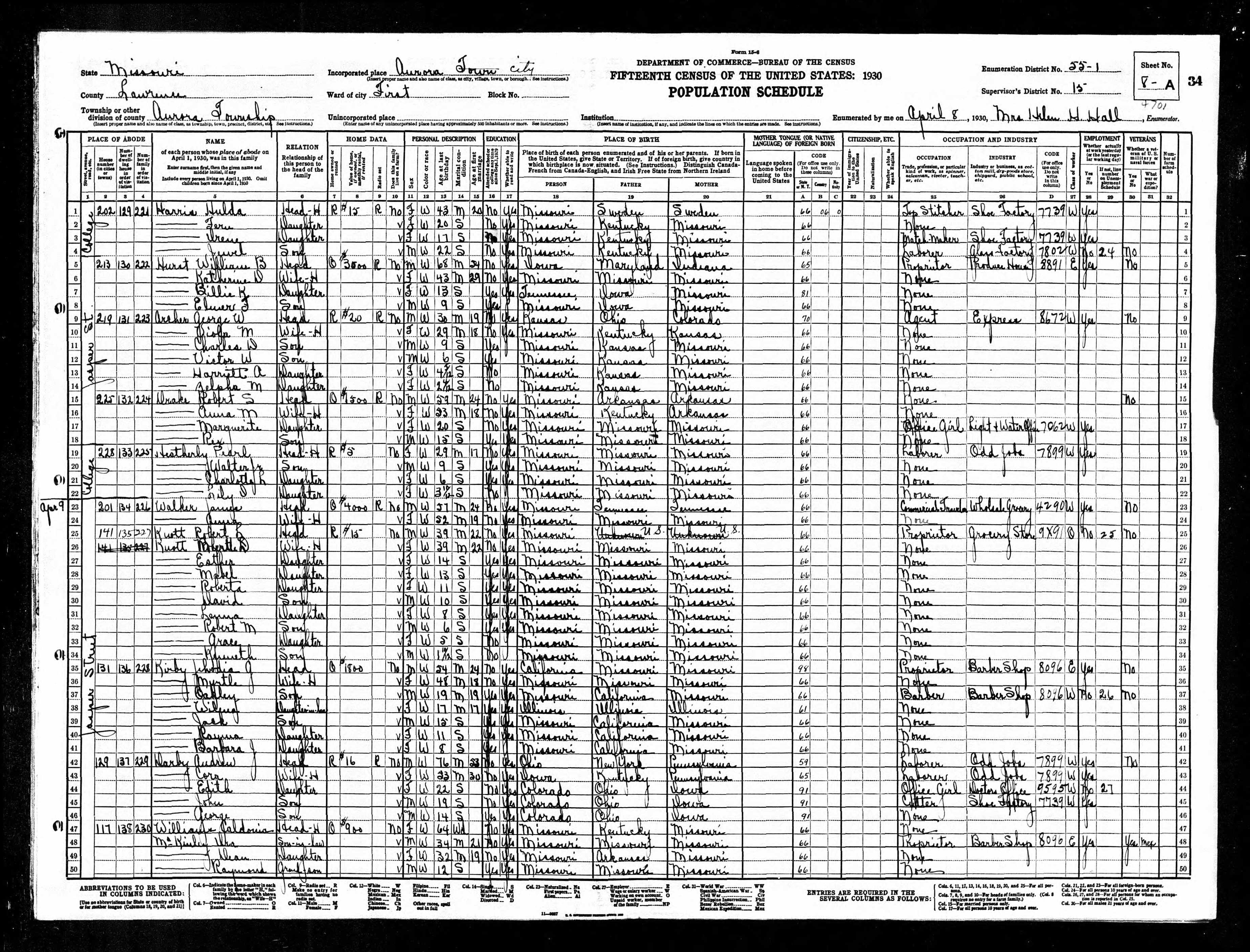Elmer Farrow Hurst (February 31, 1921–May 29, 1988)
By Kayla Rabich and Holly Baker
Early Life: Small Town Beginnings
Elmer Farrow Hurst was born on February 31, 1921, in the small town of Cabool, Missouri.1 At the time of Elmer’s birth, the population of Cabool was 905.2 His father, William B. Hurst, was born in Iowa in 1860, just prior to the Civil War. His mother Katherine D. Hurst was born in Missouri in 1887. Elmer had an older sister by the name of Billie Katherine Hurst. She was born in 1916 in Tennessee. She grew up to be a teacher in a rural district. In 1930, Elmer Hurst’s family lived in Aurora, Missouri, when the population was 3,875 people. The 1930 Census, seen here, lists Elmer Hurst’s father as a proprietor at a produce house.3
Elmer Hurst completed four years of high school.4 In 1940, at the age of nineteen, he worked as a clerk on a soil project with the Civilian Conservation Corps, or CCC.5 The CCC was a New Deal public work relief program that employed men between the ages of 18 to 25 in conservation projects in national parks and forests. Founded in 1933 at the height of the Great Depression, the CCC helped alleviate economic hardships by providing employment opportunities for many out-of-work Americans.6
Military Service: World War II and the Korean War
The United States entered World War II on December 8, 1941, the day after the Japanese attack on a naval base in Pearl Harbor in Hawaii.7 Elmer Farrow Hurst joined the Army on August 5, 1942, eight months later. Hurst enlisted at the Jefferson Barracks military post in Lemay, Missouri.8 Between 1826 and 1946, Jefferson Barracks served as an important training and reception center for the US Army.9 Hurst started as private in the Army and turned his enlistment during World War II into a career. In the early 1950s, Hurst served in the Korean War.10 Unfortunately, documentation regarding Hurst’s military duties during World War II and the Korean War could not be found.
Post-Service Life: From East Asia to Florida
Elmer Hurst served in the Army until 1962 and retired as a lieutenant colonel. In 1963, he was employed as the Foreign Service Staff Officer at the State Department in Washington, D.C.11 After his appointment, he served in East Germany, Hong Kong, Saudi Arabia, and Taiwan.12 In 1981, Hurst worked as a Budget Officer in the East Asian Bureau.13 The East Asian Bureau is part of the United States Department of State. The bureau advises the Secretary of State and Under Secretary for Political Affairs on issues pertaining to the Asia-Pacific region. The Bureau also deals with US foreign policy and US relations with Asia. The purpose of the East Asian Bureau is to coordinate, direct, and oversee U.S. government activities within the region, including diplomatic, economic, political, and administrative issues.14
Elmer Farrow Hurst moved from Washington, DC, to St. Petersburg, Florida, around 1981. In his obituary, neither a wife nor children were mentioned. Unfortunately, he was diagnosed with cancer in the last few years of his life and lived out his last days in hospice care in Pinellas Park, FL.15 His last dying wish was to be buried in the Florida National Cemetery, near Bushnell, Florida. According to a Florida Today article from June 1st, 1988, found here, Elmer Hurst wanted to be one of the first veterans buried in the new cemetery. Mary Labyak, who worked at the Hospice Care in Pinellas Park, described his final wish to Florida Today: “The staff was telling me that all along he’s been saying that’s where he wanted to be buried and he just knew he’d live long enough for that to happen.” 16 Labyak further states, “He wanted to be first. Certainly, his service to his country was the most important thing in his life.”17 Elmer Farrow Hurst died on May 29, 1988. He was laid to rest on June 1, 1988, in Florida National Cemetery.18
Endnotes
1 “U.S. World War II Army Enlistment Records, 1938-1946,” database, Ancestry.com, https://www.ancestry.com (accessed July 18, 2017), entry for Elmer F. Hurst.
2 “Missouri Population 1900-1990,” Missouri Census Data Center, Missouri.edu (accessed July 18, 2017).
3 U.S., Social Security Death Index, 1935-2014," database, Ancestry.com, http://ancestry.com (accessed July 18, 2017), entry for Billie Katherine Hurst; “1930 United States Census,” database, Ancestry.com, https://ancestry.com/ (accessed July 18, 2017) entry for Elmer F. Hurst.
4 “U.S. World War II Army Enlistment Records, 1938-1946,” database, Ancestry.com, https://www.ancestry.com (accessed July 18, 2017), entry for Elmer F. Hurst; “Missouri Population 1900-1990,” Missouri Census Data Center, Missouri.edu (accessed July 20, 2017).
5 “1940 United States Census,” database, Ancestry.com, https://ancestry.com/ (accessed July 18, 2017) entry for Elmer F. Hurst.
6 Robert Fechner, "The Civilian Conservation Corps Program." The Annals of the American Academy of Political and Social Science, 194 (1937): 129-40.
7 Wayne S. Cole, "American Entry into World War II: A Historiographical Appraisal." The Mississippi Valley Historical Review, 43, no. 4 (1957): 595-617.
8 “U.S. World War II Army Enlistment Records, 1938-1946,” database, Ancestry.com, https://www.ancestry.com (accessed July 18, 2017), entry for Elmer F. Hurst.
9 “Jefferson Barracks Military Post,” Wikipedia. Accessed July 17, 2017.
10 “Elmer F. Hurst Obituary, June 3, 1988,” Genealogy Bank. https://www.genealogybank.com (accessed July 17, 2017).
11 Ibid.
12 Ibid.
13 Ibid.
14 Bureau of East Asian and Pacific Affairs," Wikipedia. Accessed July 17, 2017.
15 “Vet Gets Dying Wish: Burial in New Cemetery,” Florida Today, June 1, 1988, Newspapers.com
16 “Vet Gets Dying Wish: Burial in New Cemetery,” Florida Today, June 1, 1988, Newspapers.com
17 Ibid.
18 Ibid.; National Cemetery Administration, "Elmer Farrow Hurst," US Department of Veterans Affairs, accessed July 17, 2017, https://gravelocator.cem.va.gov/NGLMap?ID=2349495
© 2018, University of Central Florida




